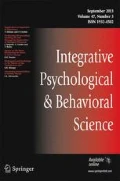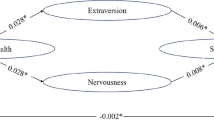Abstract
Risk factors for cancer have been found in the past to act synergistically in a number of studies. However, these studies were not always designed to test the hypothesis of synergism, and have sometimes failed to equate for important variables, which might influence the results. The present study tests the hypothesis that psychosocial variables and physical ones (personality/stress, smoking, and genetic predisposition) interact in a synergistic fashion in the causation of lung cancer and coronary heart disease (CHD).
Similar content being viewed by others
Change history
13 April 2021
A Correction to this paper has been published: https://doi.org/10.1007/s12124-021-09602-2
References
Brown, G.W., & Harris, T. (1978). Social origins of depression: a reply.Psychological Medicine, 8, 577–588.
Cornfield, J. (1962). Joint dependence of risk of coronary heart disease on serum cholesterol and systolic blood pressure: A discriminant function analysis.Federal Proceedings, 21 (suppl. 11), 98–61.
Cox, D.R. (1970).Analysis of binary data. London: Chapman & Hall.
Darrock, J.V. (1974). Multiplicative and additive interaction in contingency tables.Biometrics, 61, 207–214.
Everitt, B.G. (1977).The analysis of contingency tables. London: Chapman & Hall.
Everitt, B.S., & Smith, A.M.R. (1979). Interactions in contingency tables: A brick discussion of alternative definitions.Psychological Medicine, 9, 581–583.
Eysenck, H.J. (1990). Type A behavior and coronary heart disease: The third stage.J. soc. Behav. & Person., 5, 25–44.
Eysenck, H.J. (1991).Smoking, personality and stress: Psychosocial factors in the prevention of cancer and coronary heart disease. New York: Springer Verlag.
Eysenck, H.J., & Grossarth-Maticek, R. (1991). Creative novation behaviour therapy as a prophylactic treatment for cancer and coronary heart disease: II. Effects of treatment.Behav. Res. & Therapy, 29, 17–31.
Galtung, J. (1967).Theory and methods of social research. London: Allen and Unwin.
Grizzle, J.E., Starmer, C.E., & Koch, G.G. (1969). Analysis of categorical data by linear models.Biometrics, 25, 489–504.
Grossarth-Maticek, R. (1980). Synergistic effects of cigarette smoking, systolic blood pressure and psychosocial risk factors for lung cancer, cardiac infarction and apoplexy cerebri.Psychother. & Psychosom., 34, 267–272.
Grossarth-Maticek, R. (1989). Disposition, exposition, Verhaltensmuster, Organverschadigung und Stimulierung des zentralen Nervensystems in der Aetiologie des Bronchial-, Magen- und Leber Karzinoms.Deutsche Zeitschrift fur Onkologie, 21, 62-, 78-.
Grossarth-Maticek, R., & Eysenck, H.J. (1990a). Personality, stress and disease: Description and validation of a new inventory.Psychol. Rep. 66, 355–373.
Grossarth-Maticek, R., & Eysenck, H.J. (1990b). Personality, smoking, and alcohol as synergistic risk factors for cancer of the mouth and pharynx.Psychol. Reports, 67, 1024–1026.
Grossarth-Maticek, R., & Eysenck, H.J. (1991). Creative novation behaviour therapy as a prophylactic treatment for cancer and coronary heart disease: I.Description of Treatment, 29, 1–16.
Grossarth-Maticek, R., Eysenck, H.J., Gallasch, B., Vetter, H., & Frentzel-Beyme, R. (1991). Changes in degree of sclerosis as a function of prophylactic treatment in cancer-prone and CHD-prone dprobands.Behav. Res. & Ther., in press.
Grossarth-Maticek, R., Eysenck, H.J., & Vetter, H. (1988) Personality type, smoking habit and their interaction as predictors of cancer and coronary heart disease.Person. individ. Diff., 9, 479–495.
Grossarth-Maticek, R., Vetter, H., Frentzel-Beyme, R., & Heller, W.D. (1988). Precursor lesions of the GI tract and psychosocial risk factors for prediction and prevention of gastric cancer.Cancer Detection and Prevention, 13, 23–29.
Kannel, W.B., Neaton, J.D., Wentworth, D. et al. (1986). Overall and coronary heart disease mortality rates in relation to major risk factors in 325, 348 men screened for the MRFIT.Amer. Heart J., 112, 825–836.
Kleinbaum, D.G., Kupper, L.L., & Morganstern, H. (1982). Epidemiological research: Principles and quantitative methods.Lifetime Learning Publications, 403–418.
Koopman, J.S. (1981). Interaction between discrete causes.Amer. J. Epidemiol., 113, 716–724.
Perkins, K.A. (1985). The synergistic effect of smoking and serum cholesterol on coronary heart disease.Hlth. Psychol., 4, 337–360.
Perkins, K.A. (1987). Use of terms to describe results: “Additive”, “synergistic”.Psychophysiology, 24, 719–730.
Perkins, K.A. (1989). Interactions among coronary heart disease risk factors.Annals of Behav. Med., 11, 3–11.
Plackett, R.L. (1974).The analysis of categorical data. London: Griffin.
Rothman, K.J. (1974). Synergy and antagonism in cause-effect relationships.Amer. J. Epidemiol., 99, 385–388.
Rothman, K.J. (1976). The estimation of synergy or antagonism.Amer. J. Epidemiol., 103, 506–511.
Saracci, R. (1980). Interaction and synergism.Amer. J. Epidemiol., 112, 465–466.
Saracci, R. (1987). The interactions of tobacco smoking and other agents in cancer etiology.Epidemiol. Rev., 9, 175–193.
Selikoff, I.J., Hammond, E.C., & Charg, J. (1968). Asbestos exposure, smoking and neoplasms.J. Amer. Med. Asscn., 204, 104–110.
Tennant, C., & Bebbington, P. (1978). The social causation of depression: A critique of the work of Brown and his colleagues.Psychol. Med., 8, 565–575.
Walker, A.M. (1981). Proportion of disease attributable to the combined effect of two factors.Inter. J. Epidem., 10, 81–85.
Author information
Authors and Affiliations
Additional information
This article has been retracted. Please see the retraction notice for more detail: https://doi.org/10.1007/s12124-021-09602-2
About this article
Cite this article
Eysenck, H.J., Grossarth-Maticek, R. & Everitt, B. RETRACTED ARTICLE: Personality, stress, smoking, and genetic predisposition as synergistic risk factors for cancer and coronary heart disease. Integrative Physiological and Behavioral Science 26, 309–322 (1991). https://doi.org/10.1007/BF02691067
Published:
Issue Date:
DOI: https://doi.org/10.1007/BF02691067




